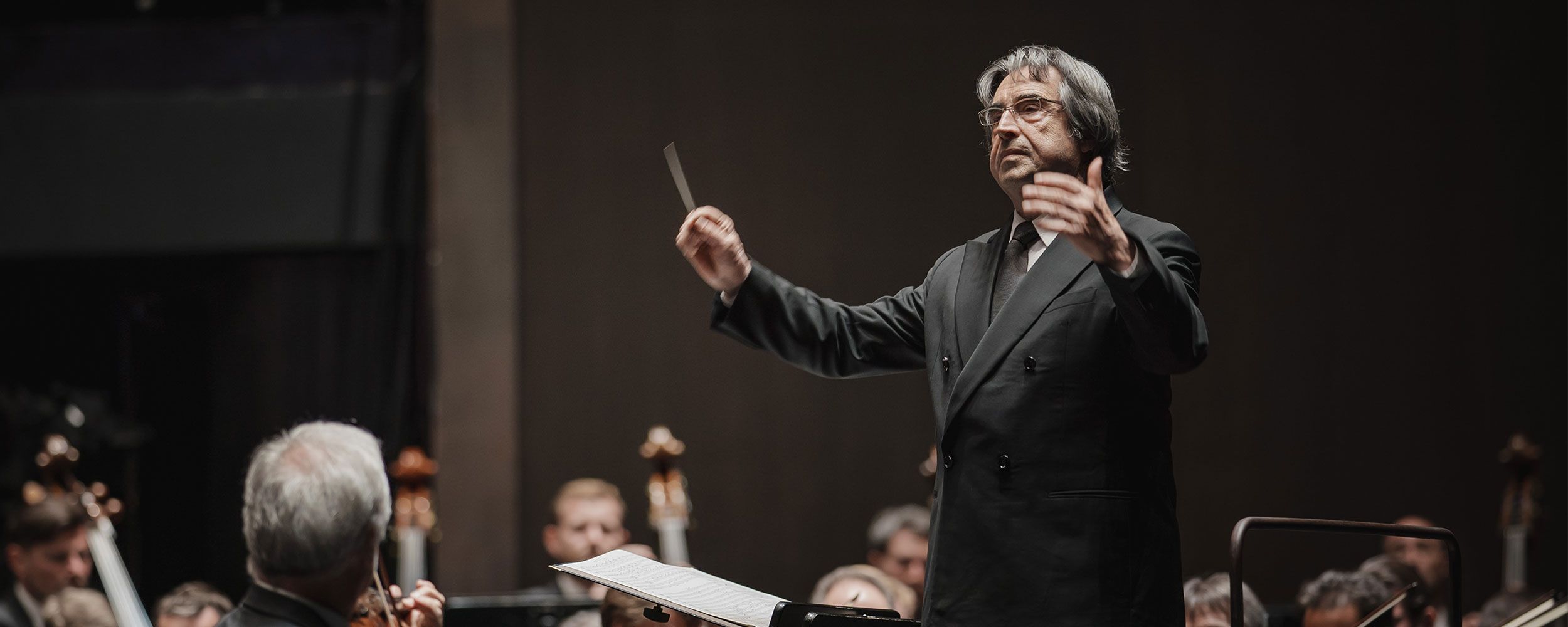Symphonic concert conducted by Riccardo Muti with Wiener Philharmoniker: May 12, 2024

On Sunday, May 12th 2024 at 5pm, maestro Riccardo Muti, leading the Wiener Philharmoniker, on the podium in the Great Hall of the Theater for a prestigious symphonic event as part of the 86th Maggio Musicale Fiorentino Festival.
Compositions by Wolfgang Amadeus Mozart and Franz Schubert are on the program.
The concert is sold out
Florence, May 11th, 2024 – An important and prestigious symphonic event enriches the 86th Festival del Maggio Musicale: scheduled in the Great Hall of the Theatre, on Sunday May 12th at 5 pm, maestro Riccardo Muti on the podium of the Maggio leading the Wiener Philharmoniker for the performance of two masterpieces with an intense Viennese flavor, proposed to enhance the character of the orchestra and its unmistakable sound: Symphony no. 35 in D major K. 385, Haffner, by Wolfgang Amadeus Mozart and Franz Schubert and the Symphony n. 9 in C major D. 944, called Die Große (The Great).
The concert at the Maggio Fiorentino represents the second stage of a short Italian tour by Maestro Muti with the Viennese Orchestra, one of the most famous orchestral groups in the world, which touched Ravenna the evening before Florence and will continue in Bari. The Maestro's partnership with the Orchestra has spread for over half a century, ever since Karajan invited Muti to conduct them at the Salzburg Festival in 1971. Since then there have been countless, more than 500, symphonic and operatic occasions in which the maestro and the orchestra have played together, including the very famous and traditional New Year's concerts which he has already conducted six times and which he will conduct again in 2025. Precisely with i Wiener maestro Muti conducted his last concert in Florence in the spring of 2021.
On the lecterns, therefore, at the opening of the concert, the lively and carefree Symphony n. 35 in D major K. 385, Haffner by Wolfgang Amadeus Mozart. The name by which the symphony is known is due to the circumstances that saw its birth. In the summer of 1782 Mozart, busy with the staging of Entführung aus dem Serail, was called from Salzburg to compose what was supposed to be a serenade. The invitation came from Sigmund Haffner who, in the past, when he held the position of burgomaster of the city, had already commissioned a serenade from Mozart (K. 250) on the occasion of his daughter's wedding. The lively tone of the first movement of the "Haffner" recalls the destination of the original serenade, as does the following Andante where strings and wind instruments dialogue with extreme grace. After a joyful and graceful Minuet, the Symphony concludes with a Rondo with a whirlwind rhythm that the author recommended should be performed "as fast as possible".
One of Franz Schubert's best-known compositions, Symphony no. 9 in C major D. 944, called Die Große (The Great), completes the concert. The symphony owes its name not only to the expansion of the ensemble, with three added trombones, but also to the language already tending towards late romantic solutions. It was originally composed by Schubert in 1828 and offered to the Society of Friends of Music in Vienna but the complexity and length of some passages impressed the orchestra, which, judging it too difficult, refused to perform it. The symphony was thus sent back to the sender who placed it in a drawer: only years after Schubert's death, Robert Schumann discovered it by chance during a visit to the brother of the deceased musician and did his utmost to send it to Mendelssohn in Leipzig, where that masterpiece until previously unknown, it regained new life in its first performance in 1839.
The program:
WOLFGANG AMADEUS MOZART
Symphony in D major K. 385 Haffner
On 16 July 1782, Entführung aus dem Serail was successfully staged and for Mozart a period of intense work began (the transcription for wind instruments of the most popular pages of Entführung aus dem Serail) and preparation for his wedding with Constanze Weber. In those days his father informed him of the request for music from the burgomaster of Salzburg Siegmund Haffner (the same commissioner of the Serenade K. 250): despite the fact that Mozart had left his hometown after the break with Archbishop Colloredo, it was a proposal which could not be refused. On July 20, Wolfgang wrote to his father: “I will work as quickly as possible, and try to write as well as the rush allows me”; on July 27th he sends the first half; on the 31st he apologizes for not having finished yet; on August 4th he gets married to Constanze and on the 7th the work (not yet a Symphony, but a Serenade) is finished.
In February 1783 his father sent the manuscript back to Vienna and Mozart, eliminating an introductory March and one of the two Minuets, found himself ready with a Symphony, the first written in Vienna, which he presented to the public of the Burgtheater in Vienna on 23 March 1783. The first tempo, Allegro con spirit, to be performed "with fire", as Wolfgang wrote, permeated by a contrapuntal tension, mindful of Bach's lesson, presents a first theme with a martial rhythm and an energetic character, which is followed by a sweet and cantabile figuration and, at the end of the exhibition, a drawing once again with a vigorous tone. The following Andante takes us back to a gentler dimension, of tender elegance, while the Minuet, with a Haydnian imprint, is once again full of energy, with an elegant Trio at the centre. The final Presto, to be performed "as quickly as possible", Mozart wrote, is based on two main themes which recur and are elaborated in a concise rondo structure.
FRANZ SCHUBERT
Symphony no. 9 in C major D. 944, Die Große
That Schubert wanted to try his hand at a large-scale symphonic work - in the manner of Beethoven, of course - was well known during his last years of life. After the symphonies composed in his youth, a sort of apprenticeship in the highest instrumental genre, Schubert felt ready for a symphony in grand style and in 1828 he signed the Symphony in C major called, precisely, 'The Great'. Offered to the Society of Friends of Music in Vienna, the new composition would have been officially performed that same year if the complexity and length of some passages had not frightened the orchestra, which, judging it too difficult, refused to perform it. The symphony was so sent back to the sender that he placed it in a drawer, as had already happened with his other precious musical jewels. Only years after Schubert's death, Robert Schumann discovered it by chance during a visit to the brother of the deceased musician and did his utmost to send it to Mendelssohn in Leipzig, where that hitherto unknown masterpiece regained new life in the first performance of 1839. The Symphony n. 9 in C major owes its name not only to the expansion of the ensemble, with three added trombones, but also to the language already tending towards late Romantic solutions. While adhering to classical construction rules, Schubert modifies the internal balance by toning down the classical thematic contrast in favor of a continuous expansion of the melodic materials used, according to a narrative logic internal to the dilated and digressive composition, defined by Schumann as 'divine length'.



